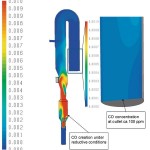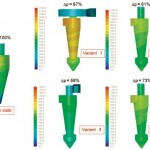Just like many other processes in the primary industry, cement production is characterised by its high flow rates and energy requirements – therefore offering considerable potential for optimisation. Computer-aided flow simulation (CFD) is a highly recommendable instrument to use in the optimisation process – especially in view of the fact that operating conditions there are severe and experimental tests difficult to gauge.
Dr. Martin Weng
Modern cement production is character-ised by its intense complexity and heterogeneity in terms of flow, temperature, phases and concentration. In a calciner, pre-heated raw meal (CaCO3) is reduced to burnt lime (CaO) in a fluidised bed process. Calcium oxide is then burned to cement clinker in a rotary kiln. Calcination occurs at high temperatures and is endothermic, making it necessary to add fuel to the calcinatory. Due to the large amounts of fuel required and the costs associated with acquiring it, more and more operators are beginning to replace conventional coal with secondary fuels such as scrap tyres, animal meal and paper or plastic waste.
The characteristics and combustion properties of these secondary fuels differ greatly from finely pulverised coal, thus influencing local temperature and concentration conditions. aixprocess, an engineering firm for process and flow technology, uses the Fluent simulation software from Ansys for its calculations. The goal is to analyse the impact of using secondary fuels on an existing production facility and provide basic engineering for possible geometric modifications or changes to operative requirements. CFD (Computational Fluid Dynamics) simulation is an essential engineering tool within this process. Individual phenomena, such as calcination reactions and combustion properties of the secondary fuels, must be converted to models and then implemented in the simulation environment before any analysis can take place. This also includes laws of resistance, constitutive equations and laws of heat transfer, which all play a role in the morphology of secondary fuels.
The CFD model
The interface between the calciner and the rotary kiln below it is the vertical duct from the kiln entrance chamber; downstream, the boundary for calculations ends just prior to the elbow of the initial cyclone heat exchanger. The calculation area contains two raw meal feed pipes for a staged calcination process as well as two feeds for primary and secondary fuels. The preheated tertiary air, which is led past the kiln in a bypass pipe, is also divided into two injection ports.
The CFD simulation of the calcinatory process is based on an approximate stationary calculation. Since the focus of the calculation is on the design of the entire appa-ratus, transient conditions are neglected after taking the usual steps to balance accuracy and computing time. The CFD model considers turbulence using a realisable k-epsilon model. Coal combustion and gas-phase species are calculated using two-step kinetics according to the sub-models included in the Fluent package. The transport of radiant heat likewise plays a pivotal role in light of the temperatures present in the calciner, particularly for particle heating and the incipient reactions connected thereto. Calcination reactions and the combustion of the secondary fuels are calculated analogously to coal combustion using a Lagrange particle dispersion model. In the gas phase, also similar to coal combustion, the program carries out observations of the N2, O2, H2O, CO2 and CO components. Sulphur compounds are excluded.
In the same way as with coal combustion, the reaction during scrap tyre combustion occurs through the pyrolysis of volatile components, although these – in contrast to coal – cannot be represented by a species due to large fluctuations in the length of the c-chains within them. This phenomenon is modelled by superimposing three species of differing chain lengths and differing kinetics. A distinctive feature of scrap tyre combustion is that the tyre chips have an initial size of less than one centimetre and decompose into particles of approximately 10 mm following complete evaporation of the volatile components. This is due to the fact that a structural framework consisting of sticky, long-chain oils and tars is missing after evaporation. This characteristic is important for mass transfer and heat transfer in coke combustion and explains the complete burnout that can be observed in real facilities.
Simulation results
The following is a presentation of selected results from the calciner simulation. In this case, 40 % of the primary fuel was replaced by secondary fuel (scrap tyres and foils) at an existing facility. The calculation clearly depicts the zones where raw meal has been added in the wake of a temperature drop due to the endothermic reaction. Despite the addition of fuel in the first, lower wid-ened section, the temperature only increases after the addition of the lower tertiary air and the ensuing oxidation.
Although the calculation of the CO concentration is only qualitative owing to uncertainties in the kinetics, the need to increase the O2 partial pressure in the reaction zone and intensify the blending process can be recognised.
Other applications for CFD
Aside from the calciner, a series of other components in the facility can be subjected to simulatory analysis and optimisation. In addition to the high quantity of necessary fuel, the principal motivation behind such an analysis is that the facilities are difficult to control due to the inhomogeneous composition of both the raw materials and the fuel, while at the same time there is a high degree of uncertainty in the measuring equipment. aixprocess is participating in the German Federal Ministry of Education and Research-sponsored project MoProOpt, which will convert reduced models into optimised processes based on detailed CFD models. As well as modelling the calciner, the project entails combining flow, reaction and heat transport in the rotary kiln with the fixed-bed reactions occurring in the bed of the kiln by depicting them with one-dimensional models.
Owing to their high throughput and constrained by the fixed ratio of solid matter to gas that is a result of the process, cement production facilities require high-performance blowers. A CFD-supported reduction in pressure loss within the individual facility components could generate significant savings in operating costs. The challenge for the CFD simulation lies in the high load of solid matter. The impact of interactions between particles and the influence of the solid phase on impulse transport can no longer be neglected. In addition to reducing pressure loss, increasing the separation efficiency of the cyclone separator is another task for CFD engineering.
Based on the Sommerfeld Collision Model, which describes the interactions of Lagrange particles in a CFD environment, the use of a physically motivated agglomeration model leads to the qualitatively accurate determination of the curve of fraction separation for a highly loaded cyclone separator. By using a flow simulation with Fluent CFD simulation software and its numerous physical models, aixprocess was able to obtain a detailed insight into the physical and chemical sequences within a complex, high-temperature process. With the help of this instrument, the cement industry could experience a dramatic increase in fuel utilisation and therefore increase the efficiency of energy and product alike.
Ansys Germany GmbH info-germany@ansys.com www.ansys-germany.com

cav: As an engineering firm, what advantages does the CFD method offer you in terms of process and flow technology?
Dr. Weng: CFD is an important tool in helping us analyse industrial processes. Its particular focus is on the numerical analysis of apparatuses with complex geometries, high-temperature processes as well as gas flows with a high dust content. These processes are all alike in that measurements of the most important individual operative parameters are often difficult, if not impossible. This is where CFD can provide key localised information concerning the status of processes for any given area within the entire system boundaries. In many cases, this allows deeper understanding of the process, creating opportunities for optimising and increasing efficiency.
cav: Could you quantify these advantages?
Dr. Weng: The use of CFD as a tool within the optimisation process can sometimes reduce expenditure significantly, as it eliminates the need for a great number of costly laboratory experiments. In addition, it reduces the amount of time required for optimisation. Savings of up to 30 % are not uncommon.
cav: What prompted your decision to choose Ansys’ flow simulation software?
Dr. Weng: Aside from providing flow simulation, Fluent offers excellent physical models for describing important phenomena within process technology and opens up a variety of interfaces for implementing our own models. From our perspective, the software serves as a generic tool that allows us to clarify a wide range of industrial issues. Its easy operability moreover allows the software to be used efficiently.
Share:









